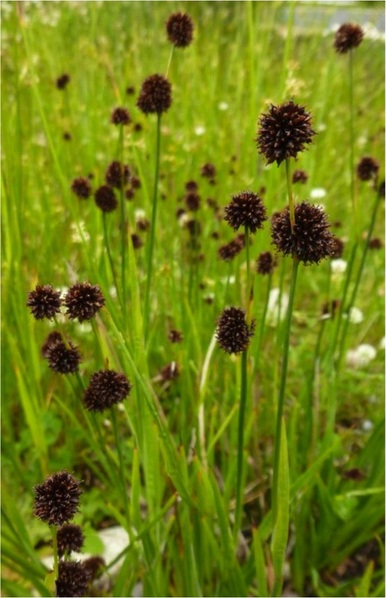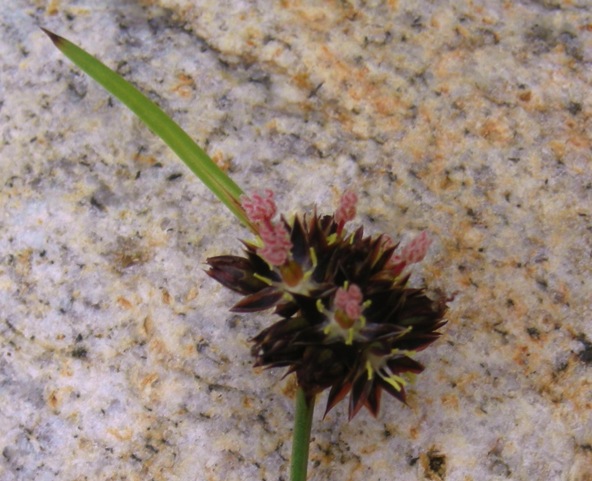Merten's rush • Juncus mertensianus
{mertensianus = for Karl Franz Mertens, a German botanist in the late 1700s/early 1800s}
Identification
Merten's rush is a perennial species, with stems that arise singly from rhizomes. It has both stem (typically 1-4) and basal leaves. Stem leaves occur lower down on stem, are almost rounded, and have prominent cross-walls. The many flowers are grouped into a single dark brown hemisphere at the apex of the stem. This species grows to 30 cm tall.
Habitat & Range
Merten's rush grows in moist to wet areas, including meadows, the edges of ponds and streams, heaths, and boggy, open-canopy forests. It is a common species in BC, and is found from middle to high elevations. It is found in western North America from California to Alaska, and east to the Yukon, Northwest Territories, Alberta, and the midwestern United States. It is also found in Japan.
Similar Species
A few other species look similar to Merten's rush, including Regal's rush and chestnut rush. The leaves of these two species are flat (those of chestnut rush are rolled under, but they are in fact flat), and there may be multiple flowering heads on the same stem, whereas Merten's rush only has one. These species are generally not found on the Central Coast.
Merten's rush is a perennial species, with stems that arise singly from rhizomes. It has both stem (typically 1-4) and basal leaves. Stem leaves occur lower down on stem, are almost rounded, and have prominent cross-walls. The many flowers are grouped into a single dark brown hemisphere at the apex of the stem. This species grows to 30 cm tall.
Habitat & Range
Merten's rush grows in moist to wet areas, including meadows, the edges of ponds and streams, heaths, and boggy, open-canopy forests. It is a common species in BC, and is found from middle to high elevations. It is found in western North America from California to Alaska, and east to the Yukon, Northwest Territories, Alberta, and the midwestern United States. It is also found in Japan.
Similar Species
A few other species look similar to Merten's rush, including Regal's rush and chestnut rush. The leaves of these two species are flat (those of chestnut rush are rolled under, but they are in fact flat), and there may be multiple flowering heads on the same stem, whereas Merten's rush only has one. These species are generally not found on the Central Coast.
References
Juncus mertensianus Bong. In Klinkenberg, Brian. (Ed.). E-Flora BC: Electronic Atlas of the Plants of British Columbia. Lab for Advanced Spatial Analysis, Department of Geography, University of British Columbia, Vancouver. Accessed 21/08/2013.
Pojar, J. and MacKinnon, A. (1994). Plants of Coastal British Columbia. Vancouver, BC: Lone Pine Publishing. P. 412.
Authors and editors of page
Kelly Fretwell and Brian Starzomski (2013).
Juncus mertensianus Bong. In Klinkenberg, Brian. (Ed.). E-Flora BC: Electronic Atlas of the Plants of British Columbia. Lab for Advanced Spatial Analysis, Department of Geography, University of British Columbia, Vancouver. Accessed 21/08/2013.
Pojar, J. and MacKinnon, A. (1994). Plants of Coastal British Columbia. Vancouver, BC: Lone Pine Publishing. P. 412.
Authors and editors of page
Kelly Fretwell and Brian Starzomski (2013).





